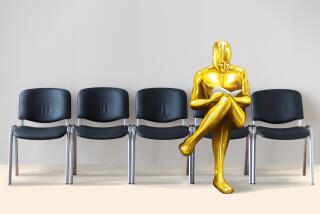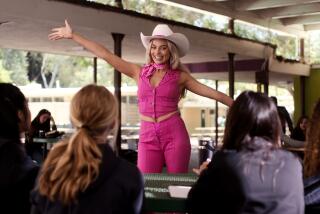Lost in the pack
Perhaps searching for stability in the Academy Awards is a futile exercise. For all that we swear we know about what Oscar voters really love -- prestige films!, comeback performances!, Meryl Streep! -- thereâs always something to make trivia hawks salivate and die-hard viewers bolt from their chairs in anger or joy. Each year surprises with what didnât get nominated, what did, how many nominations a film got, how many awards a film won compared to how many it was up for, etc.
But when youâre parsing a history that includes a best picture winner with no other nominations -- âGrand Hotelâ (1932) -- and two movies that were nominated for 11 awards and won zero -- âThe Turning Pointâ (1977) and âThe Color Purpleâ (1985) -- you realize that Oscar oddities provide a chance to examine the bigger picture.
That said, what to make of three of this yearâs five best picture nominees -- âThe Lord of the Rings: The Return of the King,â âMaster and Commander: The Far Side of the Worldâ and âSeabiscuitâ -- receiving no acting nominations?
What this yearâs occurrence literally means is that members of the acting branch of the academy didnât see fit to nominate their colleagues from three films that they might have also put up for best picture. (In the nominations process, peers select the contenders in all the categories except best picture, where everyone pitches in. Only in the final round do all academy members vote for all categories.) But there is a natural inclination to assume that somethingâs off. How can a film be up for best picture without some best acting going on?
Well, a similar troika manifested itself in 1969, with nominees âButch Cassidy and the Sundance Kid,â âHello, Dolly!â and âZ.â And a lack of acting nominations certainly doesnât preclude a filmâs nabbing the big one. Thatâs happened nine times over 75 years, starting with the first top prize winner, âWings,â and most recently 1995âs âBraveheart.â
The most egregious examples are probably the Greta Garbo-John Barrymore-Joan Crawford-studded âGrand Hotelâ and the beloved 1958 musical âGigi,â which took nine Oscars its year without an acting nomination.
âWhen you look back on those films, itâs certainly the performances that help make them,â says Turner Classic Movies host and columnist Robert Osborne, author of â75 Years of the Oscars.â âMaybe those wonderful performances in âGigiâ were so effortless that people didnât really focus on how wonderful those people were. It seems to give us the impression that actors think that just being wonderful in a comedy or musical is easy, and if you get to chew the scenery and scream and throw things, youâre doing great acting.â
But none of the three best picture nominees from this year are comedies. What does the seeming incongruity actually say, then, about the movies themselves or the movies of 2003?
âI think itâs just Hollywoodâs way of preparing audiences for the inevitable movie in which all the stars are virtual,â jokes film critic Peter Rainer. With computers able to generate nearly every aspect of a movie now, he notes facetiously that maybe âthe only surprise is not so much that no real actors were nominated in those movies but that Gollum wasnât nominated.â Letâs take each case separately.
Effects -- including Andy Serkisâ digitally rendered performance as Gollum -- are definitely a big part of âThe Lord of the Rings,â and the big question may be whether its whiz-bang qualities and the enveloping grandeur of its otherworldly scope overpowered the work of its actors. Each film in the trilogy has been up for best picture now, yet only Ian McKellenâs wise, fatherly Gandalf from âThe Fellowship of the Ring,â the first movie, has gotten an acting nod. But audiences havenât been unmoved by the characters, and this year New Line campaigned hard for Sean Astin, whose scenes as Samwise are some of âReturnâsâ most poignant, as best supporting actor.
Is the academy pronouncing âRingâ-leader Peter Jackson then the real star, the way veteran wizard auteur Steven Spielberg was viewed early in his career? Spielbergâs first three films to garner best picture nominations -- âJaws,â âRaiders of the Lost Arkâ and âETâ -- were acting shutouts too, probably because they were seen as director-driven, crafty entertainments. (When he tackled World War II in a serious way with âSchindlerâs Listâ and âSaving Private Ryan,â the academy took more notice.) With Jackson, thereâs even a hard-to-ignore visual corollary -- though not an actor, the shaggy, rotund Jackson certainly wouldnât look out of place in his own hobbity epic. It could be that his expected best director win tonight will be a performance award as well: In making this monumental trilogy, a scrappy New Zealand filmmaker had to play the part of a top-tier director and fantastically became one.
What happened to Crowe?
The omission of âMaster and Commanderâ is a little harder to figure. As viscerally complete as best director nominee Peter Weirâs conveyance of life at sea feels, Russell Crowe and Paul Bettany bring critical warmth, humor and electric camaraderie to this acclaimed adaptation of Patrick OâBrianâs beloved books. So has the often grouchy Crowe worn out his welcome with the academyâs actors after getting three best actor nominations in a row and winning for âGladiatorâ? Or did the movie just seem too stout and male to convince female voters that it was worth their time? Or, considering the on-screen charm represented by nominees Johnny Depp and Bill Murray, would citing Croweâs man-among-men charisma have deemed the best actor race a tad too lighthearted?
The horse biopic âSeabiscuitâ has a dual affliction: no acting nominations and no director nomination for Gary Ross. This isnât an impossible circumstance to overcome -- âDriving Miss Daisyâ won best picture of 1989 without Bruce Beresford getting nominated -- but it gives the film the same odds its stubby-legged subject had as a racing novice. Acclaimed actors Jeff Bridges, Tobey Maguire and last yearâs best supporting actor winner, Chris Cooper, are the redemption-seeking men at the movieâs core, but perhaps the overriding social context -- how an underdog horse soothed a depressed nationâs soul -- effectively kept the individuals around Seabiscuit sidelined. And what makes a film a success doesnât always translate into easy-to-categorize awards.
The Screen Actors Guild award committees this year didnât give nominations to Astin, Crowe, Bettany, Bridges or Maguire either. (Cooperâs stoic trainer was up for an award, though.) But the SAG honors have compensated for possibly noteworthy omissions by bestowing an award for outstanding cast, something itâs been doing for nine years. Although not limited to movies with a long roster of performers, the award means thereâs a chance that a movie powered by an ensemble wonât get left behind in a world of star turns and showy supporting roles. Last week, New Line ran full-page ads lined with rows of cast boxes -- both a campaign for the SAG award and a reminder to the academy of what it missed out on. And last Sunday, the cast of âThe Lord of the Rings: The Return of the Kingâ won SAGâs award for âensemble of a theatrical motion picture.â
âActors love that award,â says Kathy Connell, co-executive producer of the SAG Awards show. âItâs an acknowledgment that they donât act alone, that they work together.â
Thereâs a broadcasterâs savvy too in giving out a well-timed group award. It allows a program to end on the kind of communal, piling-onstage catharsis that typically signifies the best picture win at the close of the Oscars. But in terms of merit, the SAGâs cast award is one of the more satisfying recognitions of the awards season, because itâs probably the only honor that acknowledges the collaborative nature of the medium.
Ideally, the best picture award represents that kind of artistic alchemy (even though it goes to the producer/s), but in the now-fractious war among indies, specialty-arm flicks and big-budget pictures there seems to be a decisive split over what a best picture should entail. Is it something classy and large, or edgy and small? The flip side of a trio of acting-deprived Oscar-nominated films is the lack of technical nominations for their character-driven competitors. But where is the cinematography nod for the way âLost in Translationâ captured a moodily lighted, hotel-centric world? Where is the editing nomination squarely deserved for the indelible human rhythms of âMystic Riverâ?
Undoubtedly thereâs a link between the growing lack of consensus about what merits an Oscar and the myriad upheavals in the industry: the reliance on the expensive event film, the demise of the midrange picture, the muscling in of the indies and the frequent inability to determine which is a little-movie-that-could (âWhale Riderâ) and whatâs a little-movie-that-has-gigantic-coffers-to-promote-it (âCity of Godâ).
Next yearâs weird Oscar aberrance may not involve whether any films with original screenplays get best picture nominations in an industry increasingly averse to serious work without a best-selling book behind it. (âLost in Translationâ is the only nonadaptation of the 2003 best picture nominees.)
Inevitably film buffs will be scratching their heads or wringing their hands in the opening months of 2005. And maybe thatâs how it should be, if it keeps alive the dialogue on what makes a noteworthy film, or -- more entertainingly -- what goes through the minds of academy voters. âItâs why I think the Oscars have had such a lifespan,â Osborne says. âTheyâve never really allowed us to get too bored with them.â
More to Read
Only good movies
Get the Indie Focus newsletter, Mark Olsen's weekly guide to the world of cinema.
You may occasionally receive promotional content from the Los Angeles Times.










